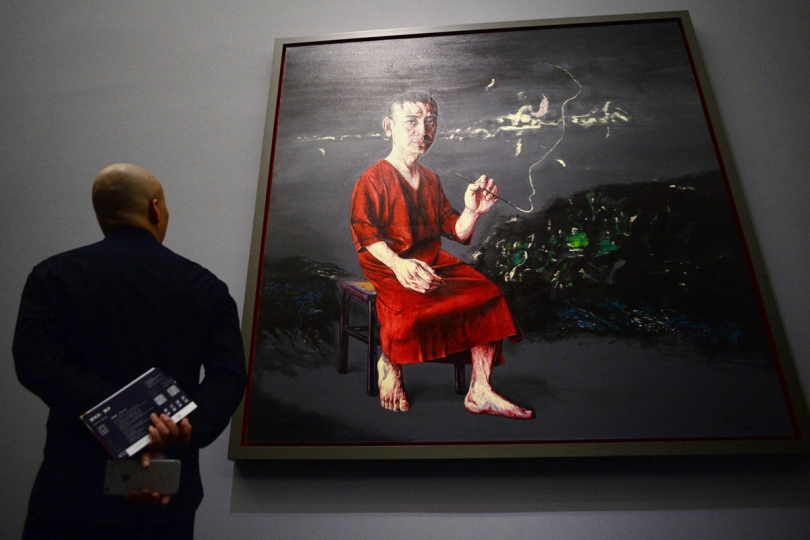Zeng Fanzhi tires of wealth

As China rises, its top-selling painter looks back to his roots
Chinese artist Zeng Fanzhi built a lucrative career by looking to the West for inspiration and buyers, but his new retrospective in Beijing reveals an unlikely return to China’s own aesthetics and tradition.
It’s a story increasingly common in the world’s second-largest economy, where growing disillusionment with material wealth has sent a generation in search of a heritage lost.
Zeng is China’s second-best-selling living artist, according to the wealth-tracking Hurun Report. He’s unimpressed with his own statistic.
“In the beginning you feel happy that you’ve attained a certain kind of recognition and your work is sold for a very high price, but as time goes on it vexes you,” he says. “People badmouth you and the success influences your emotional state and creative |process.”
His painting “The Last Supper” sold in 2013 for US$23.3 million (Bt812 million) at Sotheby’s Hong Kong, becoming the most expensive contemporary Asian artwork ever sold at auction.
It was part of his “Mask” series, paintings whose empty-eyed, white-masked figures spoke of the psychological tensions lurking in China as the political idealism of the 1980s gave way to the 1990s’ single-minded focus on rapid economic growth.
Zeng said at the opening of a retrospective of his work this month at Beijing’s Ullens Centre for Contemporary Art that the media attention paid to just one period of his nearly three-decade career left him feeling pigeonholed.
The masks became a brand, he said, an easy commodity that reinforced Western preconceptions of China and were used by auction houses and art publications to boost their own sales.
Zeng rode the wave of China’s development, rising to fame from humble beginnings at a time when the country had no significant art market of its own.
Now that its art scene is well established, he said, he’s lost the need to seek validation and inspiration from the West, choosing to look instead to his own roots.
“In the ’80s we were starved for outside information. We wanted so much to understand the world and know about Western art.” He was obsessed with artists like Paul Cezanne, Willem de Kooning and Lucian Freud.
“But nowadays there’s such an overwhelming amount of information – it’s a cognitive overload. I have to close myself off and look inward to maintain my sense of self.”
Zeng’s new show, “Parcours: Zeng Fanzhi”, features more than 60 works from each of his wildly different career stages, many being seen for the first time on the mainland. He hopes it will provide a more complete picture of his continuous process of reinvention.
Monumental abstract landscapes overgrown with dark snarls of branches dominate the gallery’s central nave, flanked by detailed portraits of his Western muses. The canvases are a stark contrast to his latest series, which entails understated, black-and-white works on paper inspired by Song Dynasty paintings.
They arise out of Zeng’s 2008 shift towards an exploration of paper itself, finding inspiration for his brushwork in the subtle variations of its grain – a technique inspired by Chinese artistic philosophies.
“As you grow older your whole aesthetic sense and preferences change,” he said. He’s started collecting traditional Chinese art and designing literati gardens, like the one outside his studio, which features jagged scholars’ rocks, stone lions and a koi pond.
Despite his philosophical shift, gallery director Philip Tinari admits it’s impossible for the show to escape the shadow of his sales records. “He’s probably created more financial value than all but a very few artists alive today.” And yet, Tinari adds, “there’s an honesty about this work that’s not immediately apparent.”
Zeng said his output is testament to a key moment in China’s artistic engagement with the outside world, when his generation found inspiration and meaning in the Western idea of art as a tool of fomenting social change.
In the recent paper series, Tinari claimed to see Zeng “pulling further and further back from the day-to-day of reality” as he grows older and wealthier, a change that echoes China’s expanding global status.
The return to a Chinese artistic vocabulary reflects not just a change in the way Zeng sees himself, but in the way the world sees Chinese artists.
As China becomes richer and more powerful, Tinari said, its artists “don’t necessarily need to make work that narrates the Chinese situation or that explains the social and political problems and questions of the nation”.
The change, he said, is a sign that China, along with its art market, is maturing. “The world is only ready to hear about art for art’s sake from people who come from a certain place on the geopolitical continuum.”
RELATED





